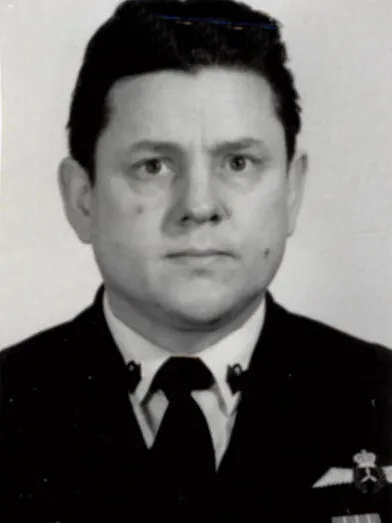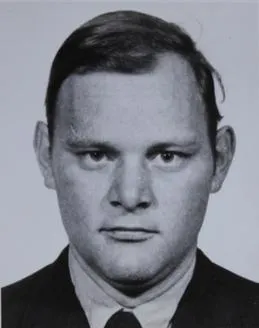Hawkes, Murray Ross (Major)
Killed in Flying Accident 1977-March-31
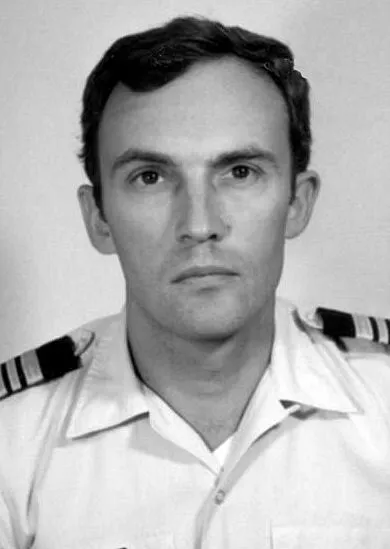

Birth Date: 1941-August-31
Born: Calgary, Alberta
Parents: Son of Murray Gordon and Margaret (nee McMorland) Hawkes of Calgary, Alberta.
Spouse: Husband of Barbara Marie (nee Gillis) Hawkes and father of Suzanne Marie and Michael Ross Hawkes of Slemon Park, Prince Ed
Home: Calgary, Alberta
Enlistment: Calgary, Alberta
Enlistment Date: 1959-September-29
Decorations: CD
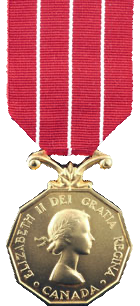
Service
RCAF
Unit
415 (MP) Sqn- Squadron
Ad Metam To the mark
Base
Rank
Major
Position
Service Numbers
O 31713
Crew or Other Personnel
Argus 20737
Argus serial: 20737
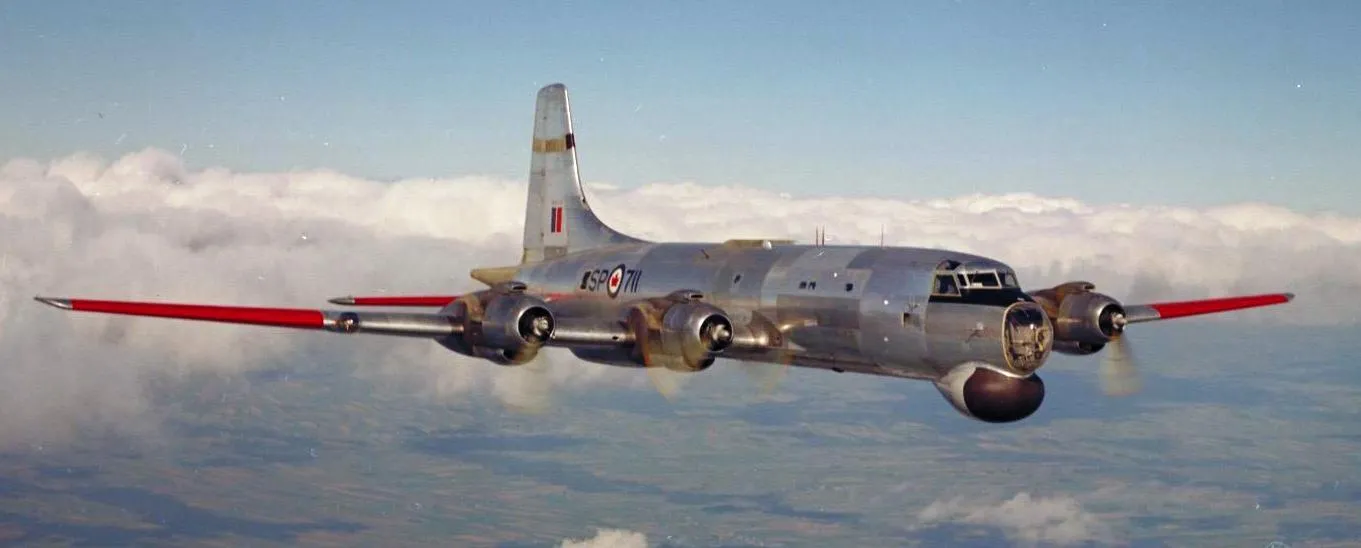
Canadair CP-107 Argus Mk. 1 (Serial No. 20711), No. 404 'Buffalo' (MP) Squadron.
The Canadair CP-107 Argus (company designation CL-28) was a maritime patrol aircraft designed and manufactured by Canadair for the Royal Canadian Air Force (RCAF). In its early years, the Argus was reputedly the finest anti-submarine patrol bomber in the world. The Argus served throughout the Cold War in the RCAF's Maritime Air Command and later the Canadian Force's Maritime Air Group and Air Command.
In 1949, Canadair recognized that the RCAF would soon be looking for a replacement for the Avro Lancasters being used in the maritime patrol role and proposed the CL-29, a variant of the North Star, itself a variant of the Douglas C-54 Skymaster or DC-4 transport. When the RCAF issued the specification in 1952, it was for a larger and more capable aircraft, and two proposals were received. These included a Lockheed Constellation variant from Lockheed, however its low speed handling was deemed inadequate by the RCAF, while Bristol proposed a variant of their Britannia airliner but concerns were raised over its floating controls, where they were controlled via servo tabs rather than direct linkages. The RCAF preferred the Bristol proposal, but it would be developed in Canada. Canadair presented two proposals, the CL-28 also based on the Britannia, which was accepted, and a lowest cost design called the CL-33 which was described as a fat Lancaster. It would have comparable to the Avro Shackleton already being operated by the RAF, but significantly lighter, and was to be powered by the same engines as were used in the CL-28, or similar radial engines.
Canadair began work on the CL-28 in April 1954 and at the time it was the largest aircraft to be built in Canada. The hybrid design, initially referred to as the 'Britannia Maritime Reconnaissance', or 'Britannia MR', was derived from the Bristol Britannia airliner, having the same wings, tail surfaces and landing gear except for being "Americanized" meaning that it used the same general design, but changed from British materials, dimensions and standard parts to American ones. Due to the greater stresses from flying at low altitude for long periods of time, even the components taken from the Britannia needed substantial reinforcement, and to meet these demands, extensive use of a locally developed metal to metal bonding was used. The Argus represented the first large scale use of titanium in the structure, as well as structural plastic, which was used to electrically insulate the top of the fin for the sensors mounted there.
The fuselage was completely redesigned by Canadair, going from the pressure cabin used in the Britannia to an unpressurised one with two 18 ft (5.5 m) long bomb bays fore and aft of the wings. The powerplants werre also changed from the Bristol Proteus turboprop engines to Wright R-3350 turbo-compound piston radial engines, which had lower fuel consumption necessary for extended missions at low level. At the design stage the Napier Nomad, another turbo compound engine was also considered, although the Nomad was later cancelled. Wikipedia
Unit Desciption
415 (MP) Sqn Ad Metam ("Swordfish")
History of the Squadron during World War II (Aircraft: Beaufort I, Hampden I, Wellington XIII, Albacore I, Halifax III & VII)
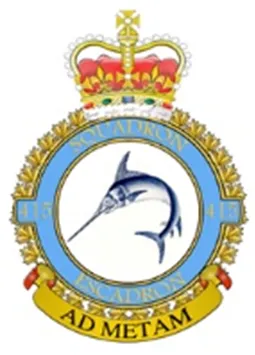
The squadron was the 13th RCAF squadron formed overseas, at Thorney Island, Hampshire, England ![]() on August 20, 1941. It was a originally a torpedo bomber squadron, briefly flying Bristol Beaufort Mk 1 (but not operationally) before transferring to Handley Page Hampden aircraft, with the squadron letters GX. The squadron flew from a number of bases as part of Coastal Command Nos 16 and 19 Groups. Over the course of 1942, these bases ranged from the south of England (St. Eval, Cornwall) to the north of Scotland (Wick, Caithness). In November 1942, it settled at Thorney Island for a year before moving to Bircham Newton, Norfolk, in November 1943. From September and October 1943, the squadron flew Wellington Mk. XIII and Fairey Albacore Mk. I, the latter having the squadron code of NH. The squadron was active on D-Day, laying smoke screens for the Allied shipping. After D-Day, there was less need for maritime operations, and the squadron was designated 415(B), was equipped with Handley-Page Halifax III and VII aircraft, and joined 6 Group (RCAF) of Bomber Command, flying from East Moor, Yorkshire
on August 20, 1941. It was a originally a torpedo bomber squadron, briefly flying Bristol Beaufort Mk 1 (but not operationally) before transferring to Handley Page Hampden aircraft, with the squadron letters GX. The squadron flew from a number of bases as part of Coastal Command Nos 16 and 19 Groups. Over the course of 1942, these bases ranged from the south of England (St. Eval, Cornwall) to the north of Scotland (Wick, Caithness). In November 1942, it settled at Thorney Island for a year before moving to Bircham Newton, Norfolk, in November 1943. From September and October 1943, the squadron flew Wellington Mk. XIII and Fairey Albacore Mk. I, the latter having the squadron code of NH. The squadron was active on D-Day, laying smoke screens for the Allied shipping. After D-Day, there was less need for maritime operations, and the squadron was designated 415(B), was equipped with Handley-Page Halifax III and VII aircraft, and joined 6 Group (RCAF) of Bomber Command, flying from East Moor, Yorkshire ![]() (RCAF No 62 Base),where it remained until the end of hostilities. Its squadron code was changed to 6U [this is according to Moyes and Wikipedia, but Kostenuk gives "GU", which may be a misprint]. Its last mission was on April 25, 1945. The squadron was disbanded at East Moor on May 15, 1945.
(RCAF No 62 Base),where it remained until the end of hostilities. Its squadron code was changed to 6U [this is according to Moyes and Wikipedia, but Kostenuk gives "GU", which may be a misprint]. Its last mission was on April 25, 1945. The squadron was disbanded at East Moor on May 15, 1945.
In the course of the war, the squadron flew 1645 torpedo bomber operations for a cost of 33 aircraft, and was credited with 5 ships sunk, with 2 damaged and 2 others shared. In its bomber role, 1608 sorties were flown for the loss of 22 aircraft, dropping 5041 tons of bombs and 798 tons of incendiaries. The crews were awarded 1 DSO, 86 DFC's and 1 Bar to DFC, 1 GM and 9 DFM's. Battle Honours were: Atlantic 1942, English Channel and North Sea 1942-44, France and Germany 1944-45 Biscay Ports 1944, Ruhr 1944-45, German Ports 1944-45, Normandy 1944, Rhine, Biscay 1942-43.Wikipedia, Kostenuk and Griffin
Squadron History (Bomber Command Museum PDF)
Maps for Movements of 415 Squadron 1941-45

MAP 1: 415 Squadron Movements Dec 1941-Aug-42 (right-click on image to display enlarged in new tab)
|

MAP 2: 6 Group Bomber Bases 1943-45
|
415 Squadron History Summary 1941-45
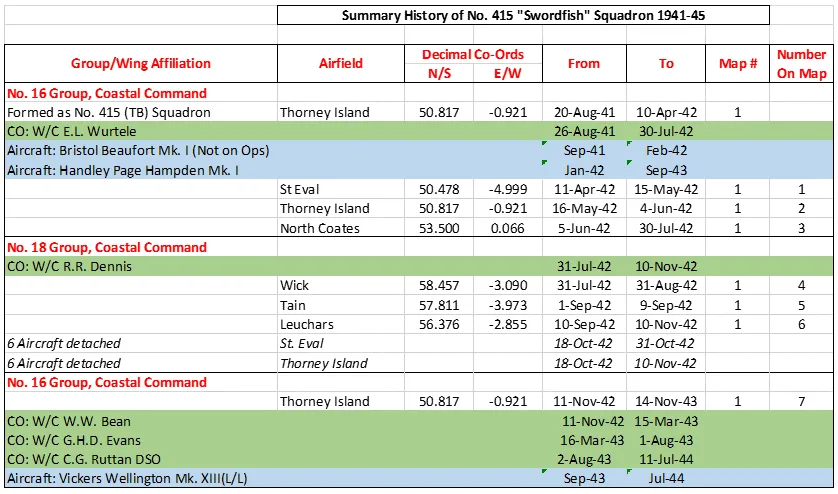
415 Squadron History Summary 1941-45 Page 2

History of the Squadron Post-WWII (Aircraft: Argus, Aurora)
The squadron was re-established as a Maritime Patrol squadron on 1 June 1961 at RCAF Station Summerside, Prince Edward Island ![]() , and equipped with the Canadair CP-107 Argus. The Squadron was quick to establish a Canadian endurance record on 26 July 1961, flying 30 hours and 20 minutes, non-stop. During its two decades at Summerside, the Swordfish squadron conducted a variety of missions including anti-submarine, fisheries and pollution, and Northern sovereignty patrols, operating from an ever-increasing number of deployment locations. In 1964, the Squadron assumed the Search and Rescue duties for the Maritime Air Command. In 1981, all the Maritime Patrol Squadrons converted to the Lockheed CP-140 Aurora aircraft and all the East Coast CP-140 squadrons were consolidated at Canadian Forces Base (CFB) Greenwood
, and equipped with the Canadair CP-107 Argus. The Squadron was quick to establish a Canadian endurance record on 26 July 1961, flying 30 hours and 20 minutes, non-stop. During its two decades at Summerside, the Swordfish squadron conducted a variety of missions including anti-submarine, fisheries and pollution, and Northern sovereignty patrols, operating from an ever-increasing number of deployment locations. In 1964, the Squadron assumed the Search and Rescue duties for the Maritime Air Command. In 1981, all the Maritime Patrol Squadrons converted to the Lockheed CP-140 Aurora aircraft and all the East Coast CP-140 squadrons were consolidated at Canadian Forces Base (CFB) Greenwood ![]() . On the afternoon of 24 July 1981, Argus 736, call sign "Sidney 02", conducted a fly-past for a ceremonial parade to celebrate 415 Squadron’s welcome to Greenwood; its Change of Command ceremony, and, the last official Canadian Forces flight of the Argus. In 1982, the Squadron received its Standard in recognition of 25 years of dedicated service to the Crown and the people of Canada.
. On the afternoon of 24 July 1981, Argus 736, call sign "Sidney 02", conducted a fly-past for a ceremonial parade to celebrate 415 Squadron’s welcome to Greenwood; its Change of Command ceremony, and, the last official Canadian Forces flight of the Argus. In 1982, the Squadron received its Standard in recognition of 25 years of dedicated service to the Crown and the people of Canada.
Operationally, Iraq’s invasion of Kuwait in 1990 prompted Canada to send a naval task group to enforce the United Nations’ resolutions. 415 Squadron was tasked to support this task group during its work-up phase during transit from Halifax to the Mediterranean Sea. The Aurora exercised the self-defense capability of the Canadian Task Group and provided surface surveillance. In 1993, Operation SHARP GUARD brought crews from 415 Squadron to Sigonella, Sicily, ![]() where they flew surveillance patrols in the Adriatic in support of the United Nation’s arms embargo of the Former Republic of Yugoslavia. The Squadron later participated in Operation ASSISTANCE, providing humanitarian assistance to the people of Manitoba during the great flood of 1997. Throughout the 80s and 90s, anti-submarine warfare training and anti-submarine patrols remained the focal point for 415 Squadron. With the end of the Cold War and new asymmetric threats emerging, the Aurora fleet became more involved in overland missions; to align the CP140 fleet with this new reality, all the CP140 squadrons were rebranded as Long Range Patrol (LRP) Squadrons. 415, along with the other LRP Squadrons, were active participants in Operation APOLLO, deploying crews to the Arabian Sea region in support of the American-led Campaign Against Terrorism (CAT) following the events of September 11, 2001. The first two crews rotated through on deployments of six months duration. For the remainder of the operation, crews were rotated every 56 days. The CP-140 commitment to Operation APOLLO ended in July 2003.
where they flew surveillance patrols in the Adriatic in support of the United Nation’s arms embargo of the Former Republic of Yugoslavia. The Squadron later participated in Operation ASSISTANCE, providing humanitarian assistance to the people of Manitoba during the great flood of 1997. Throughout the 80s and 90s, anti-submarine warfare training and anti-submarine patrols remained the focal point for 415 Squadron. With the end of the Cold War and new asymmetric threats emerging, the Aurora fleet became more involved in overland missions; to align the CP140 fleet with this new reality, all the CP140 squadrons were rebranded as Long Range Patrol (LRP) Squadrons. 415, along with the other LRP Squadrons, were active participants in Operation APOLLO, deploying crews to the Arabian Sea region in support of the American-led Campaign Against Terrorism (CAT) following the events of September 11, 2001. The first two crews rotated through on deployments of six months duration. For the remainder of the operation, crews were rotated every 56 days. The CP-140 commitment to Operation APOLLO ended in July 2003.
As a follow-on to Operation APOLLO, the LRP fleet, under the direction of 1 Canadian Air Division Headquarters, developed a Squadron Vanguard posture for future potential missions. 415 Squadron was the first unit selected, holding Vanguard from 1 April to 30 September 2004, maintaining a high readiness to rapidly deploy worldwide. In September 2004, coincident with the close of 415 Squadron’s Vanguard liability period, came the call to support NATO naval units in the Mediterranean conducting Operation ACTIVE ENDEAVOUR, with the mission to deter, monitor and intercept potential threats of terrorism in the Mediterranean Sea; to defend NATO member nations against terrorists operating at sea; and, to demonstrate resolve and presence in the campaign against terrorism. By mid-October, one crew and support staff from 415 Squadron along with 14 and 19 Wing (Comox) technicians and aircrew, were in theatre and flying Operation SIRIUS missions out of Sigonella. Soon thereafter, on 29 July 2005, 415 Squadron was stood down for a second time.
In 2015, it was decided to merge the capabilities and expertise of 14 SES and MPEU into a single unit that would optimize frontline operator and engineering input into the ongoing development of the platform, and the associated mission/training support systems. This would allow for a more efficient, holistic approach to deal with the software/hardware complexities and to fully realise the vast potential of the AIMP-upgraded Aurora, now dubbed the CP140M. As such, after a 10-year absence, 415 Squadron and the Swordfish were stood up to once again proudly serve the government and people of Canada.
